Last updated: 5th February 2022
Table of Contents
Turbulent Past, Bright Future
After visiting Siem Reap and the temples of Angkor, we finished our tour of Cambodia with a short flight to the country’s cosmopolitan capital city of Phnom Penh. It has a population of 2 million where the very rich and poor live side by side. The old city is near the river where you’ll find the main sights, while the historical sites of Cambodia’s genocides are located outside of the city.
We paid for a couple of nights at the small La Rose Boutique Hotel & Spa which was lovely, especially the welcoming smell of lemongrass coming in from the traffic outside. We used tuk tuks to get around and yep there’s lots of chaotic traffic and pollution but we were getting used it by now after witnessing bonkers traffic in Ho Chi Minh City and Hanoi in Vietnam. At least the roads are nice wide boulevards and tree lined, a legacy of this former French colony.
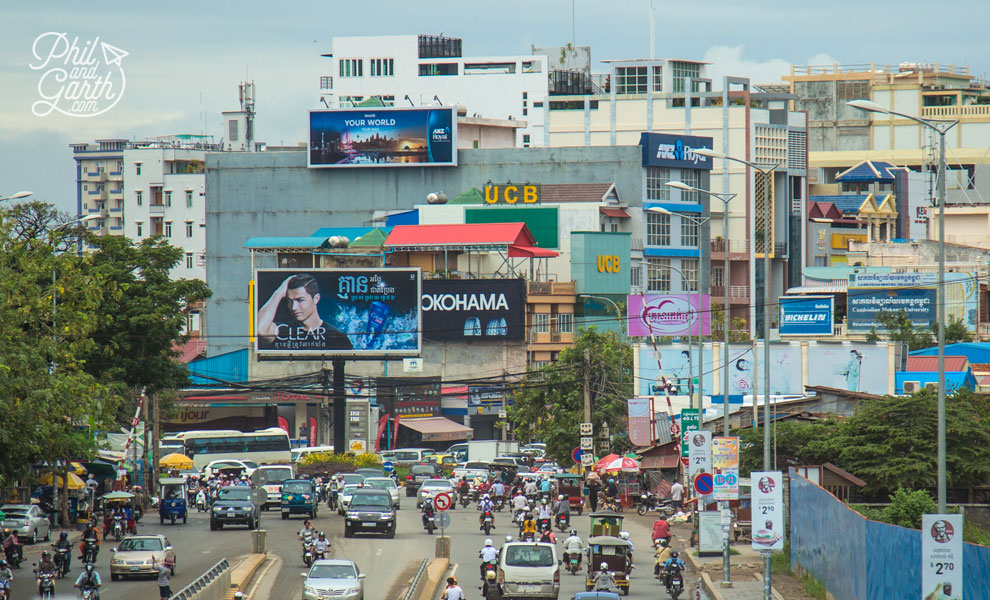
A view across a part of Phnom Penh
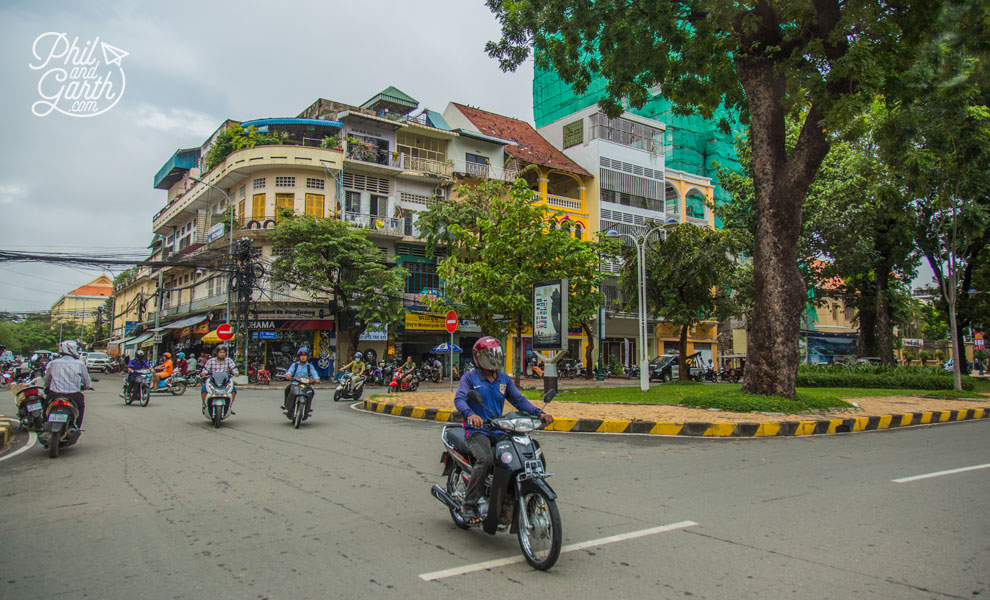
Most of Phnom Penh’s streets are wide boulevards
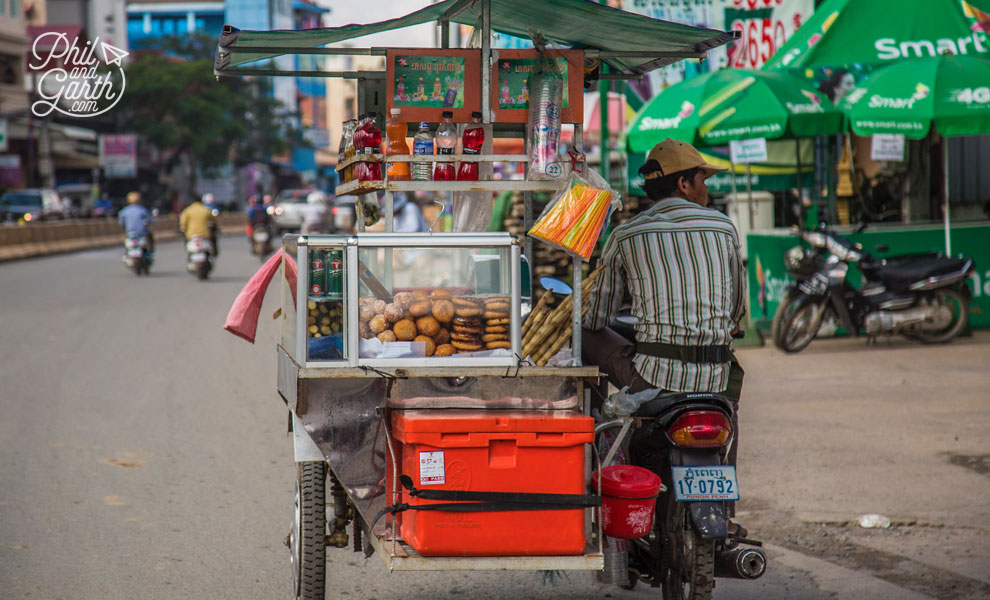
Plenty of street food vendors on bikes
Gold & Silver Palaces
Situated on the riverfront, behind a yellow compound wall is The Royal Palace. It was the last palace built during the French colonial period, now it’s a symbol of the Kingdom of Cambodia and the official residence of the King. With our guide and our US$5 entrance fee we started our tour. Make sure you cover up! long trousers or a skirt below the knees, a short sleeve shirt is ok but definitely no sleeveless tops otherwise you’ll be refused entry.
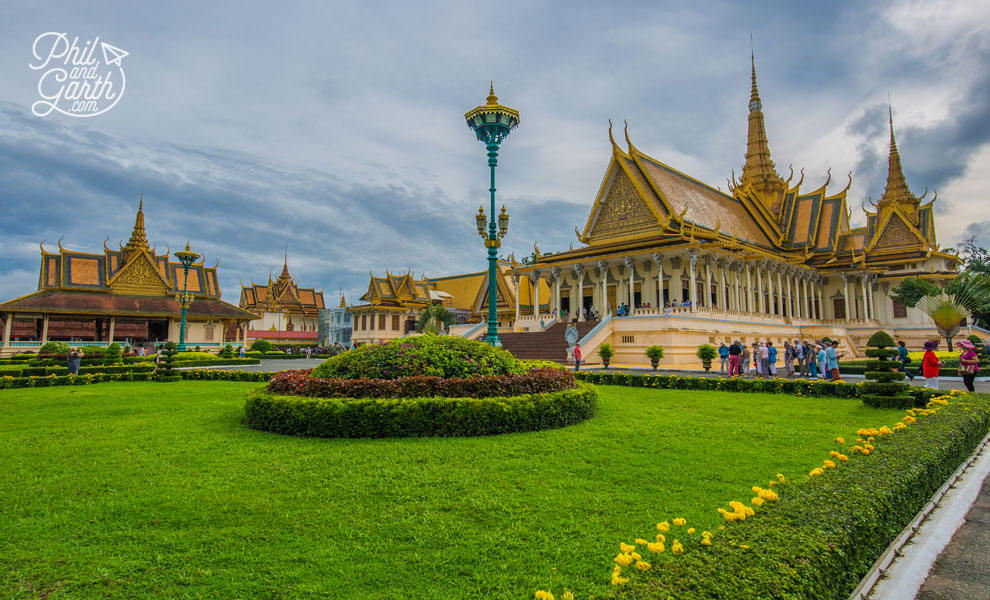
The Royal Palace
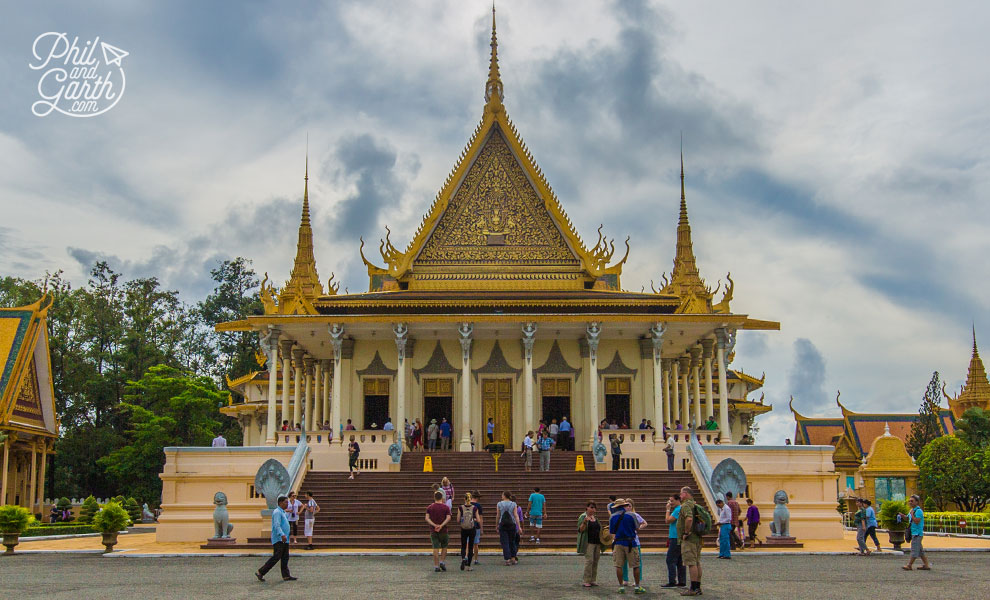
The Royal Throne Hall
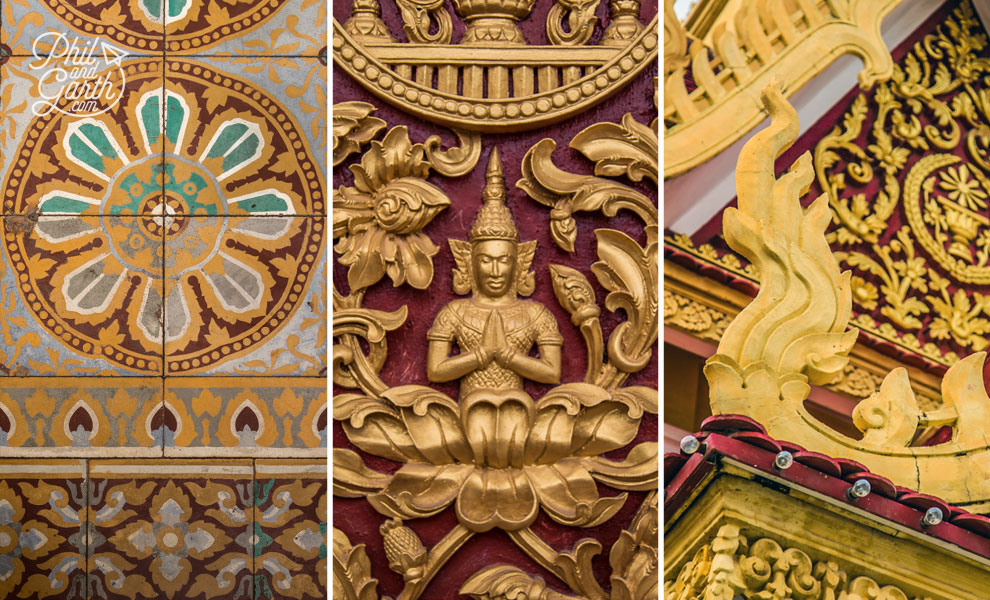
Ornate gilding of the Throne Hall
Built in 1866 The Throne Hall is used for diplomatic and other state functions. You can’t take photos but you can peer through the windows and see two enormous gold thrones and ceiling murals. Outside look up to the top of the spire for a motif of the all-seeing king, inspired by the Bayon temple at Angkor. Oh and if you see a small blue flag is flying this means the King is in residence.
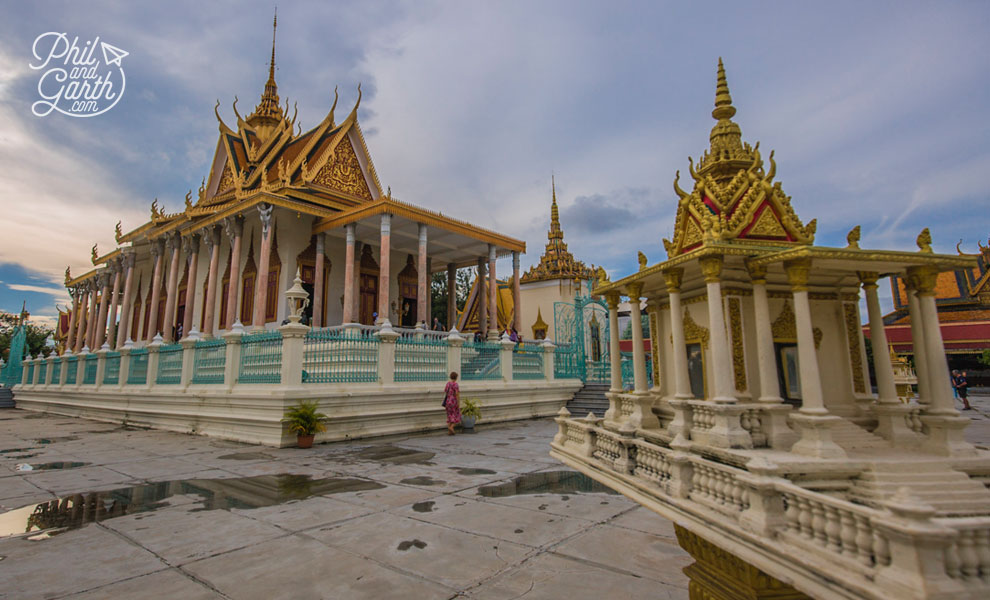
The Silver Palace
Inside the Palace compound is Wat Preah Keo Morokat, better known as The Silver Pagoda. Named after its glittering silver floor tiles all 5,329 of them. You can see a portion of them in a small viewing area near the entrance, the rest of the floor is covered to protect them. It also houses a priceless Emerald Buddha and just in front of this the main attraction – the solid gold, diamond encrusted Buddha with 9,584 diamonds to be exact.
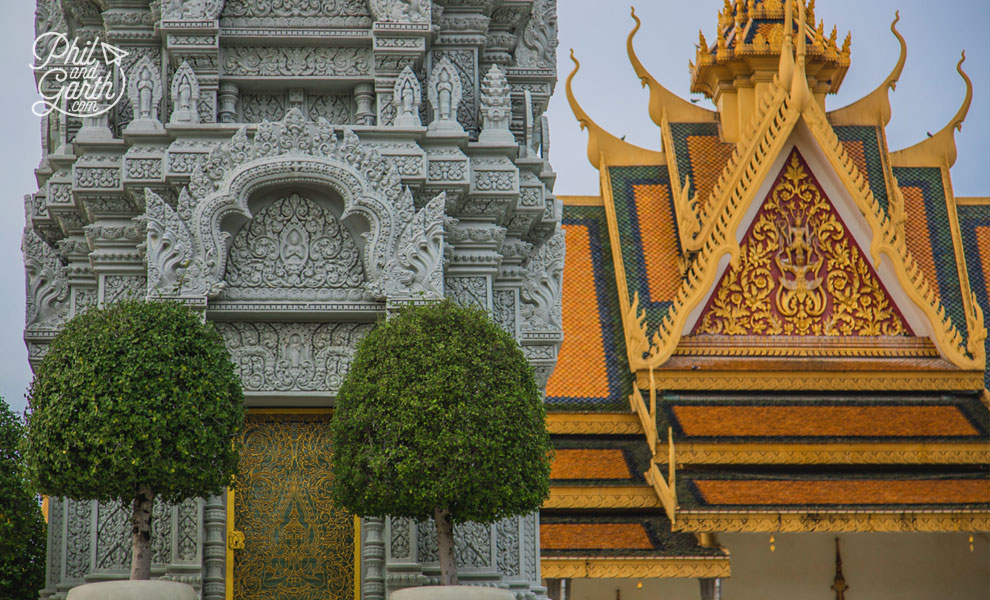
Stupa of HRH Princess Kantha Bopha
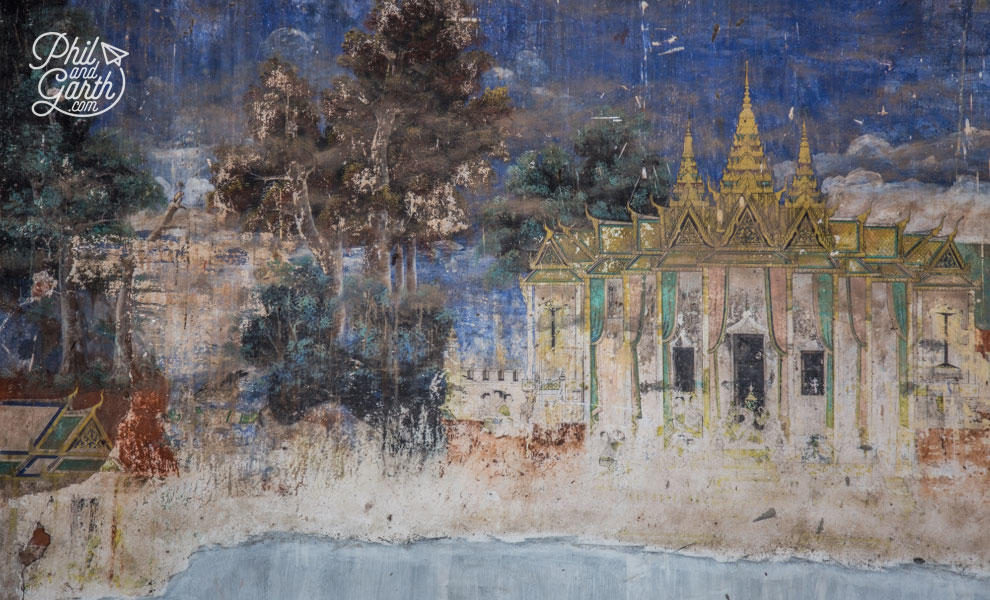
Old Khmer art on a compound wall
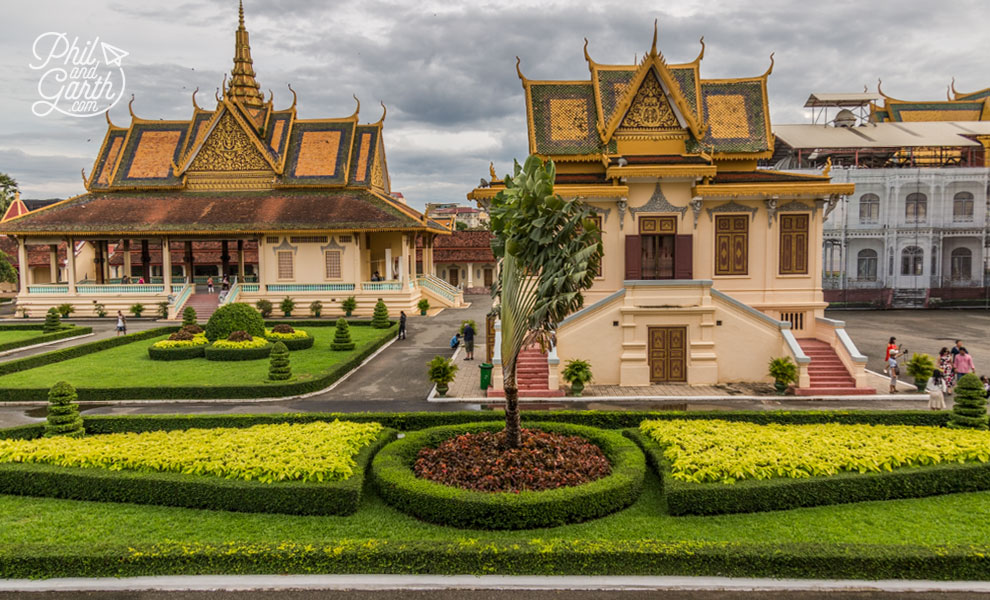
Immaculate gardens
Garth loves gardening and was impressed by the grounds which were stunning. Lawns were beautifully manicured and the flower beds stuffed with simple but classy displays.
Wat Phnom
From the Palace and a tuk tuk ride away we took the stairs up to the buddhist temple – Wat Phnom which stands at the top of Mount Penh, the only hill in the city. The temple is dedicated to Madame Penh who according to legend discovered 4 Buddha statues in 1373 this is where the origins of the city began and where the city’s name comes from. There were loads of couples and families, obviously a popular hangout.
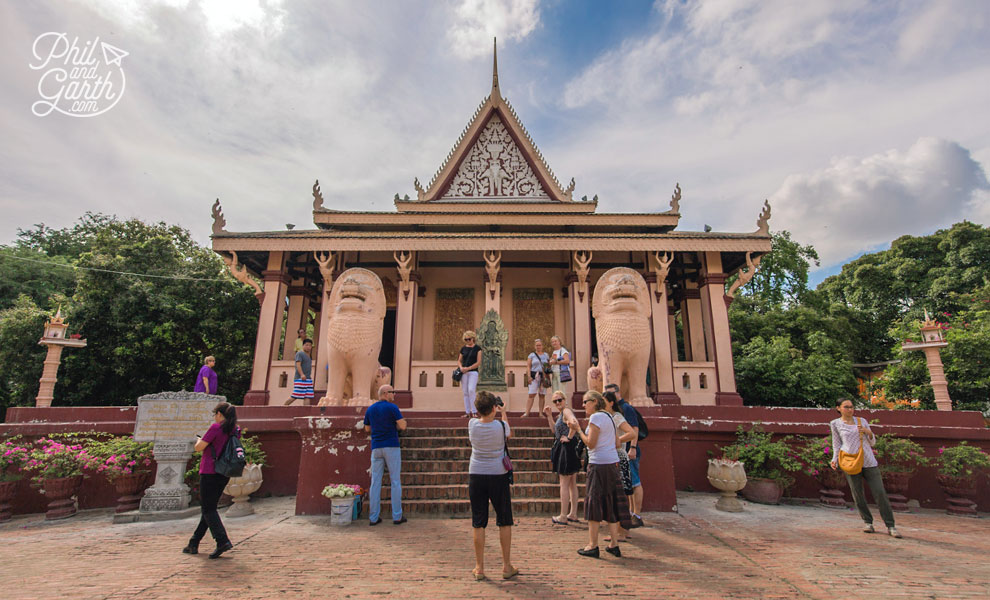
Wat Phnom, Buddhist temple
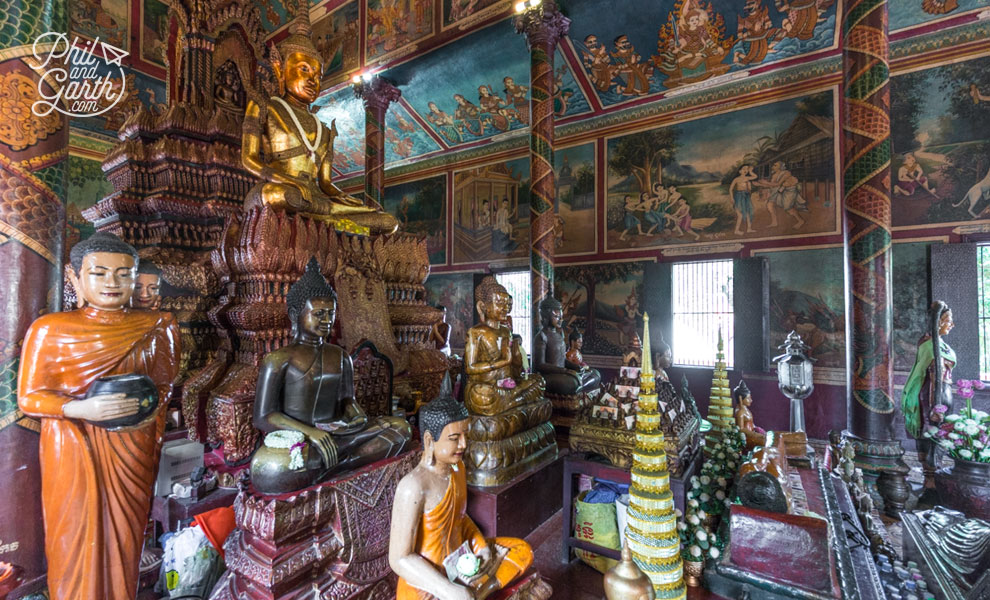
Inside Wat Phnom
Around the corner and down some steps was a little Chinese temple and inside a small shrine, this is where Garth did what the locals do, and got a glimpse into his future! He made a donation and took the tube holding wooden sticks that are numbered and started shaking them slowly until one jumped out. Exchanging the stick for his fortune on a bit of paper – ah slight issue! it was all in the Khmer language, so we’ll never know! maybe someone reading this can help us?
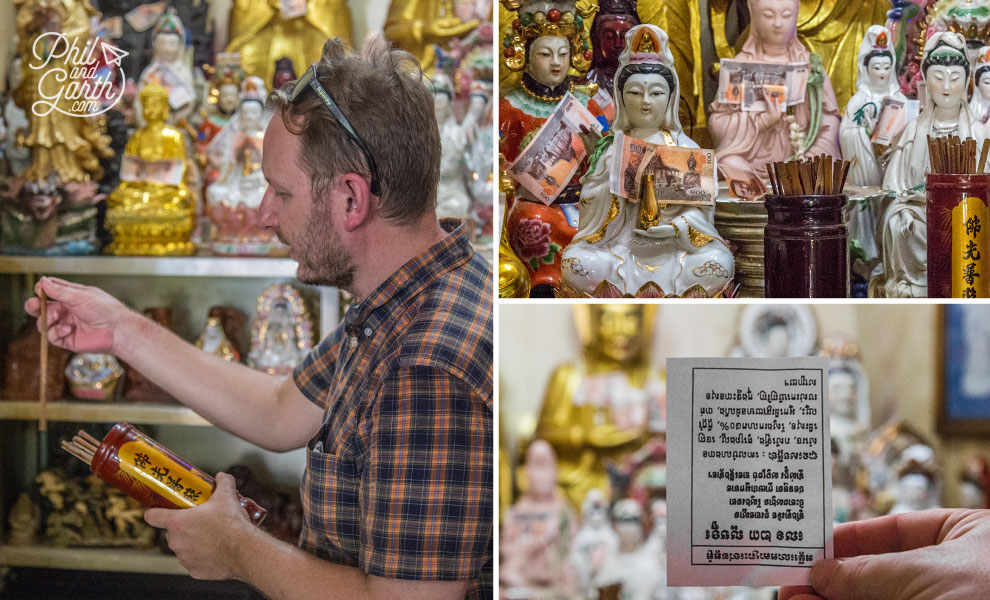
Garth getting his fortune at Wat Phnom
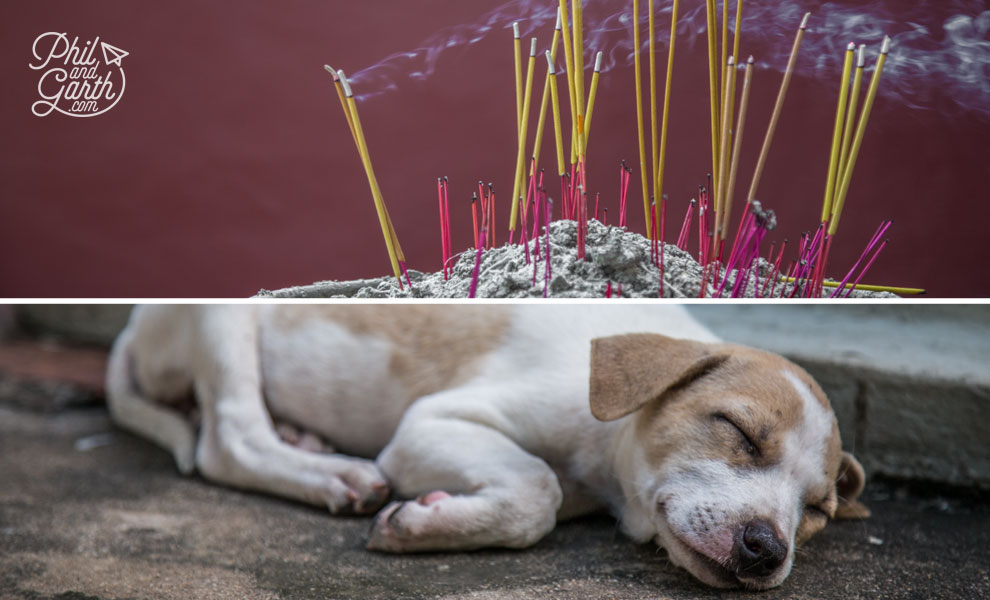
Making the most of the shade at Wat Phnom
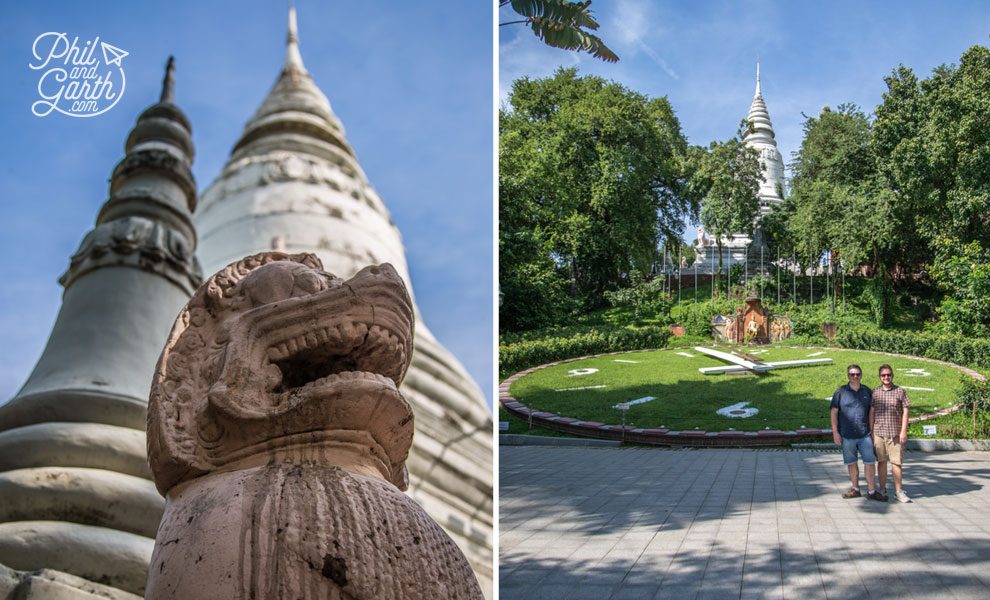
Phil and Garth at Wat Phnom
Khmer Art
We explored the collection of ancient Khmer art at the National Museum of Cambodia. Over 5,000 sculptures, relics and artefacts dating back over 1,500 years are on display. Most of the highlights are from the Angkorian era, their prize possession is the legendary statue of the ‘Leper King’. The courtyard and gardens were really attractive and a lovely tranquil place to sit and relax. But we definitely preferred seeing the art relics in situ at the temples when we visited Angkor. If you want to take photos inside you can pay an additional fee and get given a lanyard. Garth was feeling the effects of Phnom Penh’s tropical heat here and had to sit most of it out.
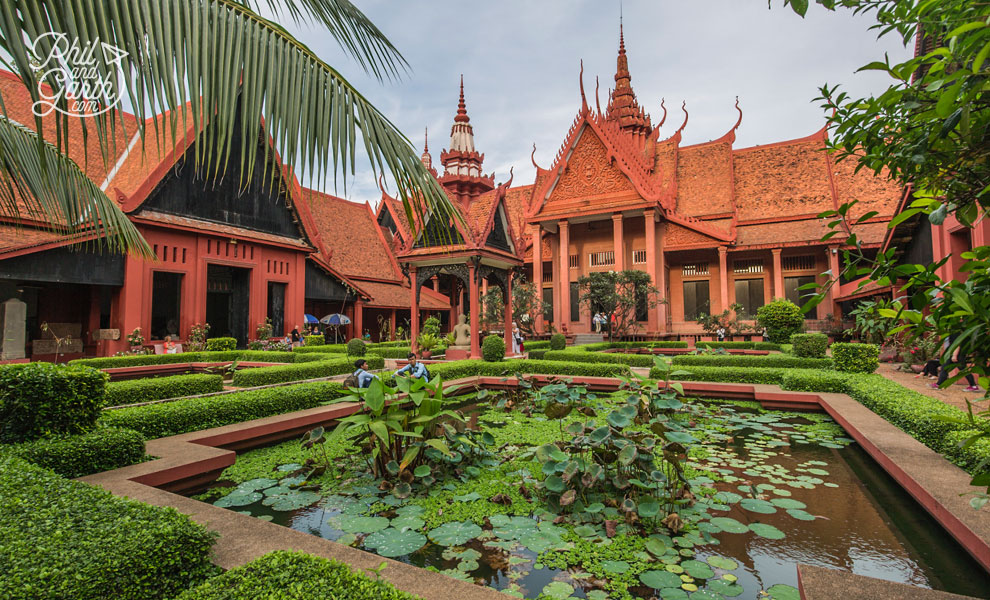
The National Museum of Cambodia
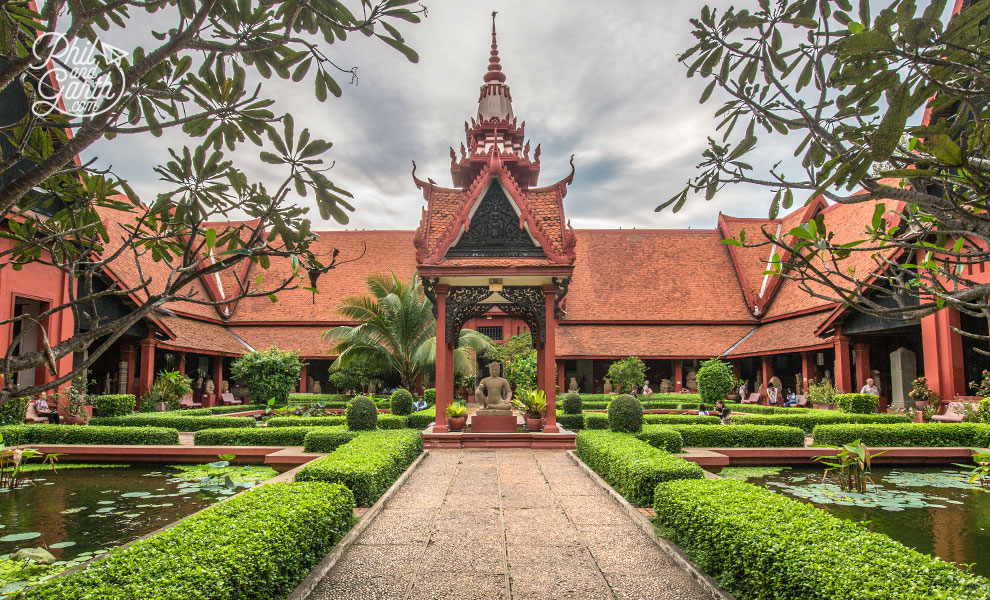
Their prize possession – The Leper King sits in the courtyard
Independence Monument
A major landmark of Phnom Penh is the Independence Monument. Built in 1958 it celebrates Cambodia’s independence from French rule in 1953. Designed Angkorian style, a lotus flower shape based on the towers of Angkor Wat. You’re not allowed inside which is ok as it’s best viewed across the road. You’ll probably pass it a few times at the busy roundabout like we did in tuk tuks. We thought it looked more impressive at night.
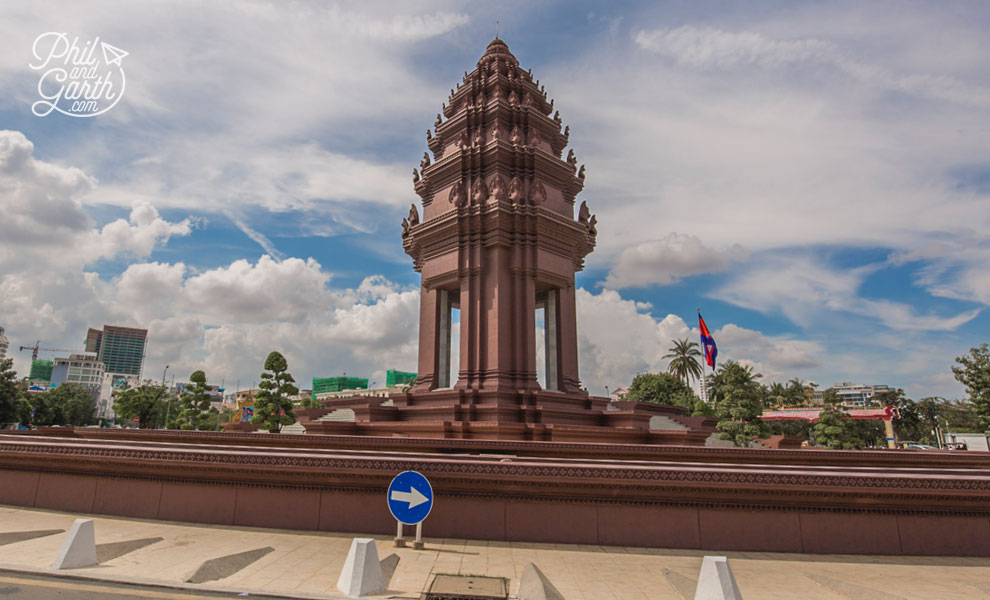
The Independence Monument
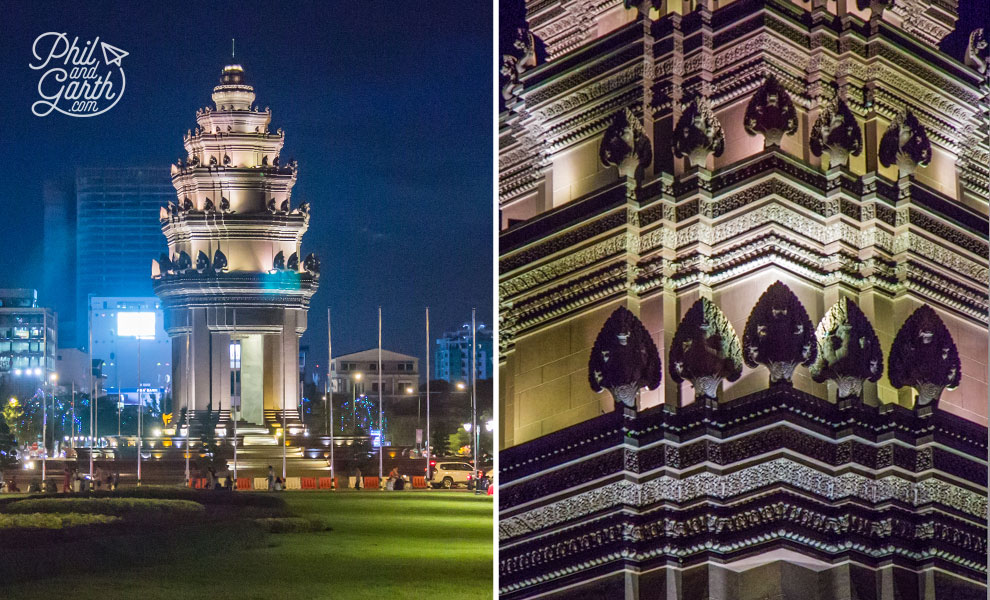
Each level is decorated with snake heads
Foreign Correspondents Club
Looking for a nice drink? then head to the Foreign Correspondents Bar or The FCC. It used to play a vital role in journalism after its opening in 1993, shortly after Cambodia gained peace and had its first general election. The club became an icon of the city and an important meeting place for foreign journalists, correspondents, diplomats, aid workers and military officers who would socialise over ice cold beers. Today it has a roof top terrace, some hotel rooms and is known as a venue for live music and entertainment. Because we both work in tv newsrooms we felt it appropriate to go have a drink. We got there at happy hour, a result! and had 2 for 1 long island ice tea cocktails.
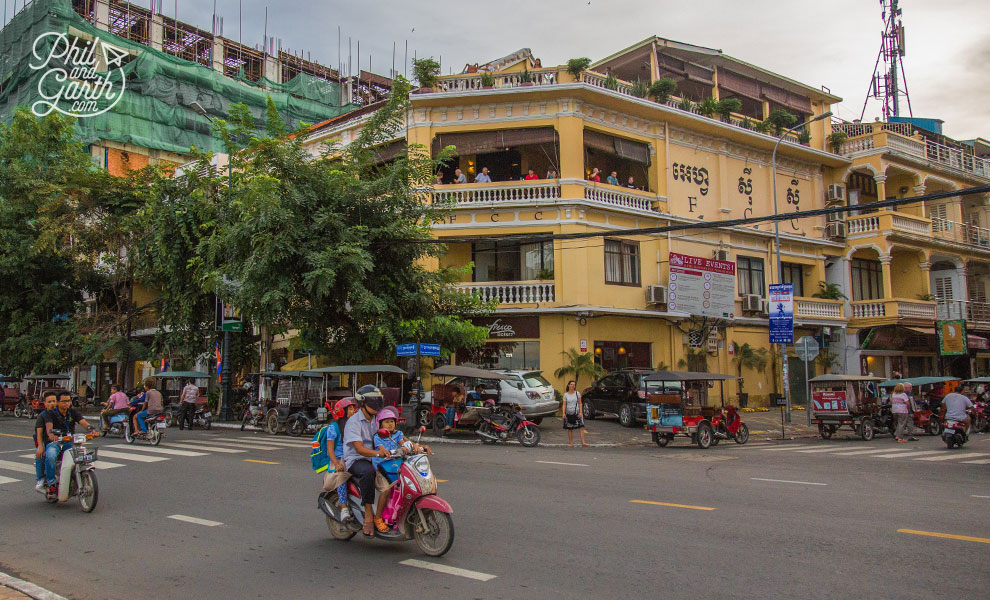
The Foreign Correspondents Club

Garth and Phil at the Foreign Correspondents Club
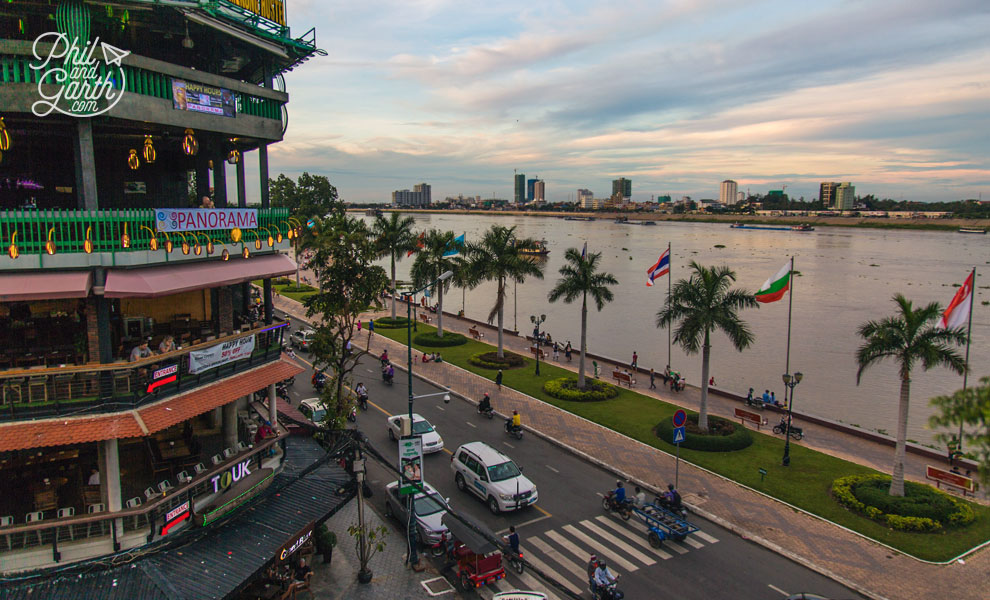
The view from the top of the FCC
The FCC is located on the Sisowath Quay a delightful promenade, excellent for a walk and a bit of people watching. On the roof top terrace we watched the sunset through the clouds over Phnom Penh.
Food & Crispy Creepy Crawlies
Our first meal was at Friends a charity run restaurant not far from the National Museum. They help disadvantaged and local street kids, by training them in cookery and hospitality with the aim to get jobs in the service industry, the food was excellent.
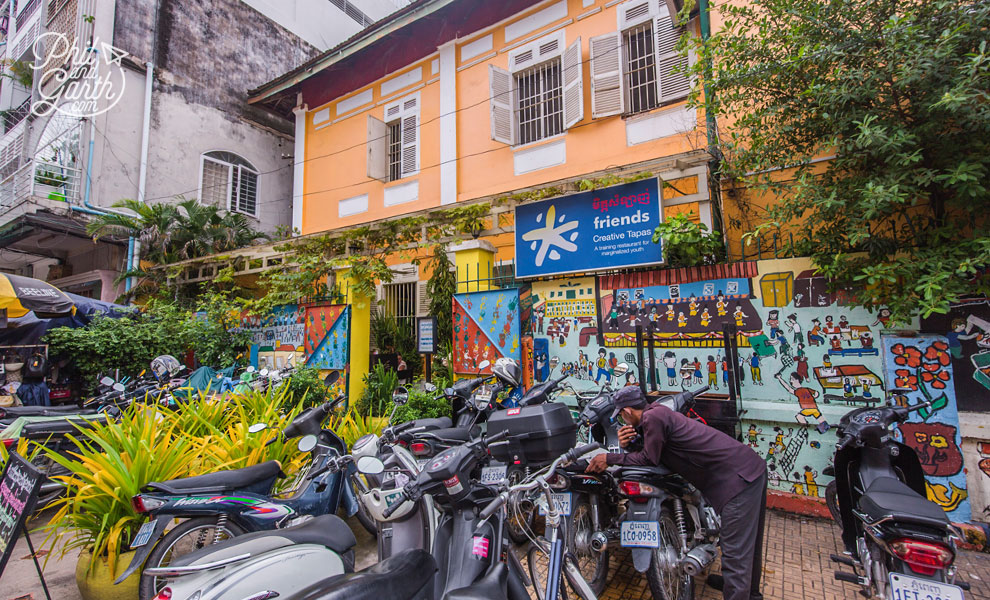
Friends, Phnom Penh
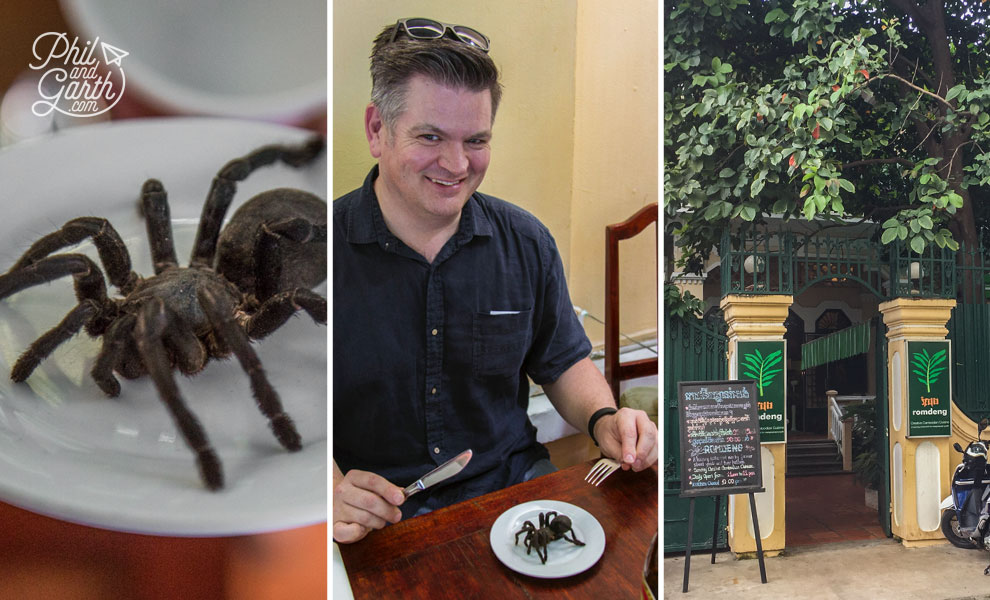
Eat fried tarantula at Romdeng
We also tried their sister restaurant Romdeng where Phil got the fright of his life! when offered fried tarantula (yes!!) Phil chickened out and opted for spring rolls and Garth had chicken curry, both delicious!
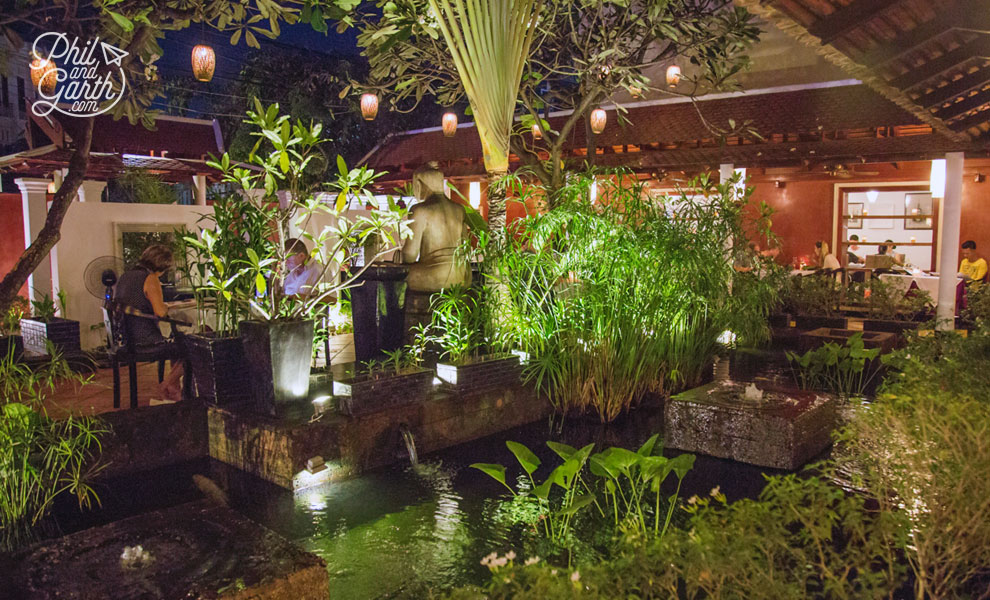
Atmospheric evening at Malis
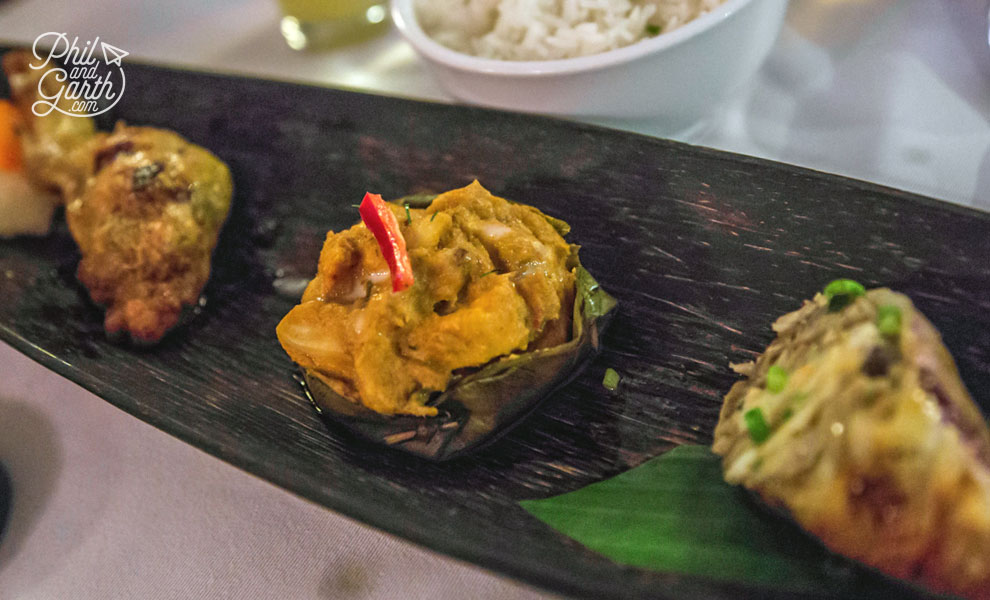
The tasting menu at Malis
For something a bit more fancy we went to Malis Restaurant and had the tasting menu US$30 which included the traditional Khmer dish Fish Amok, which was also the dish we made during our cooking lesson in Siem Reap. Malis is run by a celebrity chef, Luu Meng. It was a lovely and atmospheric evening with nice dim lighting in chic surroundings. Food is incredible value for money in Cambodia.
The Killing Fields of Choeung Ek
We decided to visit the Choeung Ek Genocidal Center about 10 miles south of Phnom Penh. We felt it was important whilst we were there to learn about Cambodia’s dark history – the mass killings committed between 1975 – 1979 by the brutal Khmer Rouge led by Pol Pot. We’d heard of the killing fields but knew very little about it.
Pol Pot wanted an ultra-communist regime and take Cambodia back to the Middle Ages. He forced people to work in fields, as he wanted a peasant agricultural society called ‘Year Zero’ some kind of utopia in his eyes. An obsessed individual he feared modern society and mass rebellion from the population, so his answer was to round up all professional and educated people from teachers to doctors and academics even people wearing glasses or those that could speak a foreign language were considered dangerous.
These people were taken to ‘houses’ code names for the prisons and forced to admit crimes they didn’t commit. They were then taken to Choeung Ek, a former Chinese cemetery that became a killing field where around 20,000 people were bludgeoned to death to save on expensive bullets and thrown into mass graves. There were many killing fields across Cambodia, Choeung Ek in Phnom Penh is the most visited.
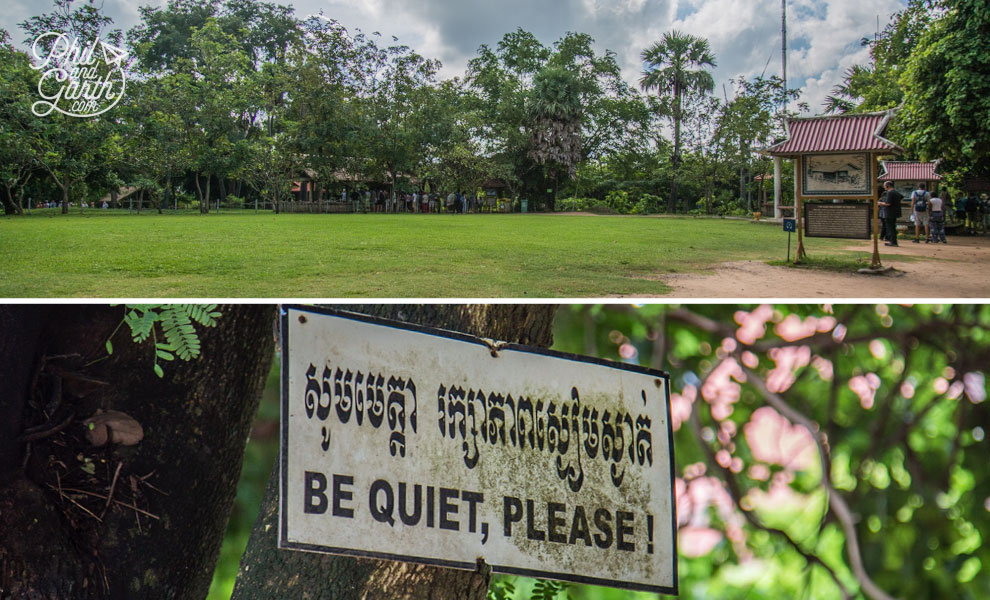
The Killing Fields of Choeung Ek
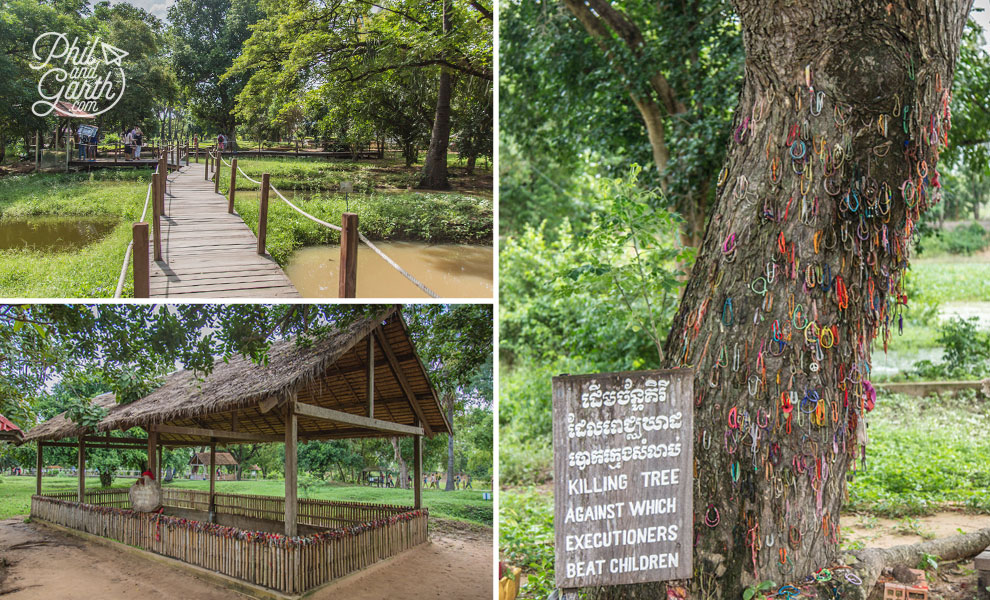
Mass graves and the horrific killing tree

Teeth and clothes revealed in the mud pits
The audio guide is superb, it’s heart wrenching and very emotional at times, but it gives you chance to learn – by listening to chilling accounts from survivors and perpetrators. As you walk around the memorial site you are given the chance to contemplate at what you are looking whilst haunting music plays in your ears. It’s a hellish place on earth where bones and teeth and clothes are still washed up in the mud pits during heavy rain. Perhaps the worst part to comprehend was the killing tree used to kill babies. As well as all this mass murder, many thousands of people starved to death in Cambodia. Pol Pot killed almost a third of the population 2.5 million people, a huge figure that’s hard to comprehend.
We couldn’t help thinking why didn’t the West help and prevent it from happening earlier? Thankfully the terror ended in 1979 when Vietnam captured Phnom Penh. Everything is so recent and we realised any Khmer people over the age of 40 it must still be incredibly traumatic and raw, even the guide we had at the Royal Palace mentioned members of his family were killed.
It felt wrong taking photos, but they encourage you to show the world, so future generations can learn from it. How can humans be so cruel? and do terrible things to other human beings? We also thought of what was happening in Aleppo, Syria at the time we were there, why don’t we learn from history?
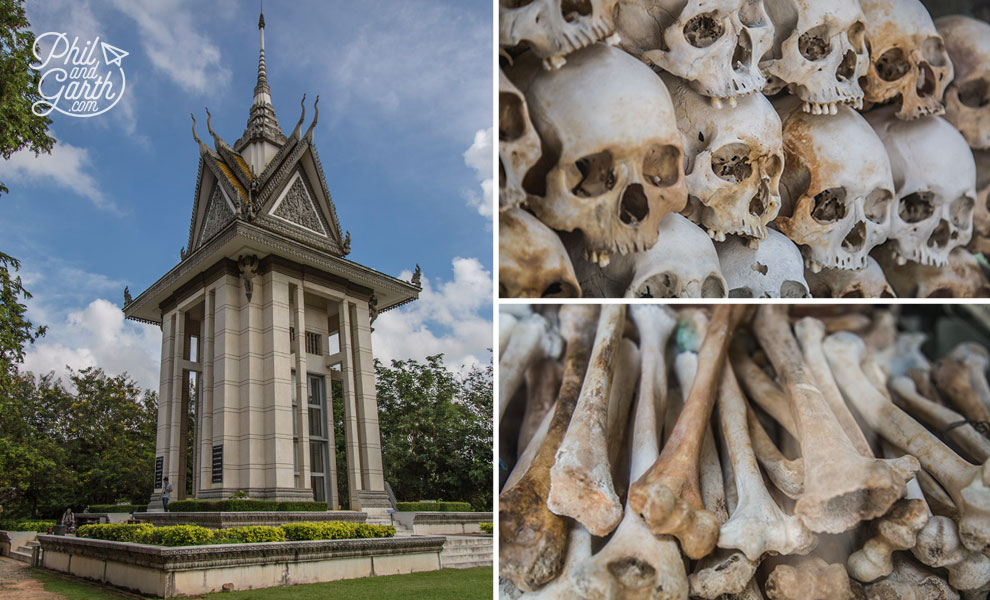
The Choeung Ek Stupa containing the skulls and bones of victims.
As we exited there’s a Buddhist Stupa – a memorial containing thousands of skulls and bones, it was haunting inside, sad and depressing, but it was important to have seen it and we’ll never forget. Yes, this is ‘dark tourism’ travel is not just about beautiful vistas and beaches, it’s about seeing the truth and being educated and challenging our opinions. We both thought it was a very humbling experience.
Tuol Sleng Genocide Museum]
Situated just outside the city is one of the ‘houses’ the S-21 prison, a detention centre under the Khmer Rouge regime, the site now serves as the Tuol Sleng Genocide Museum. It was part of a network of 200 secret prisons where people were tortured and forced to make false confessions of treason. They didn’t know of their fate, but it was to be taken to the Choeung Ek killing fields.
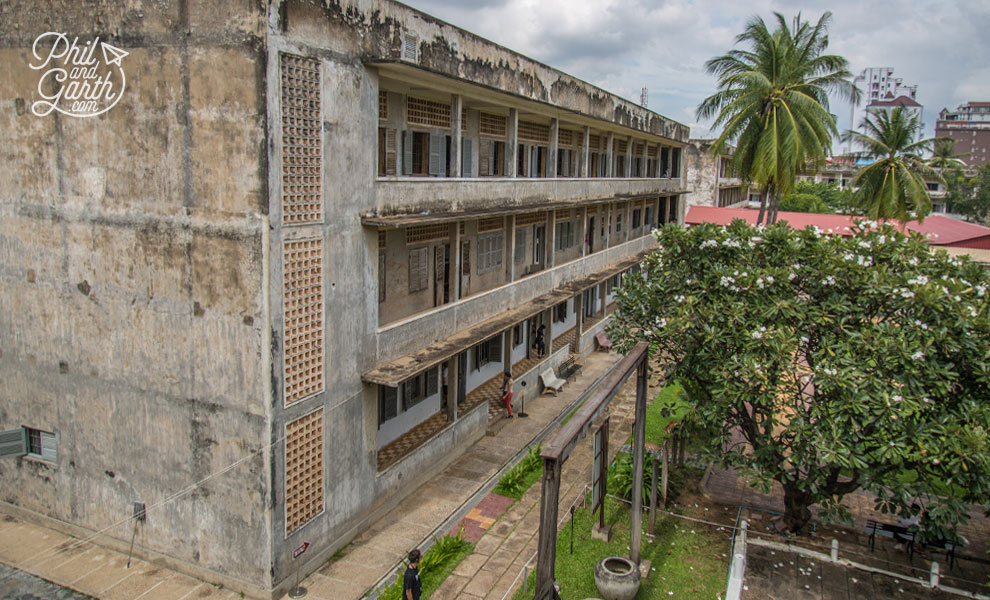
Phnom Penh Tuol Sleng Genocide Museum
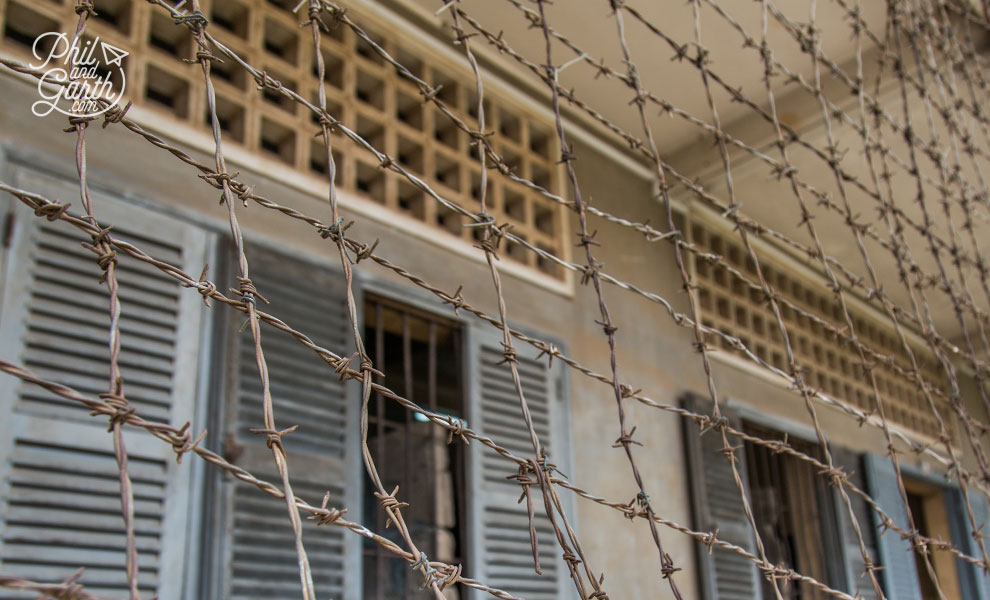
Barbed wire was installed to stop people trying to jump and commit suicide
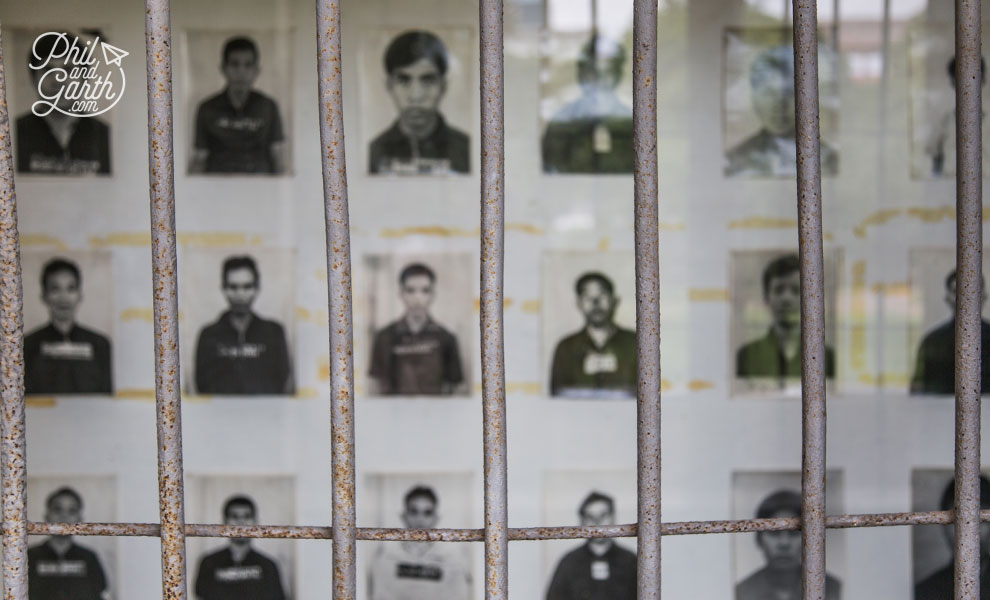
Behind bars – the victims of the S-21 Prison
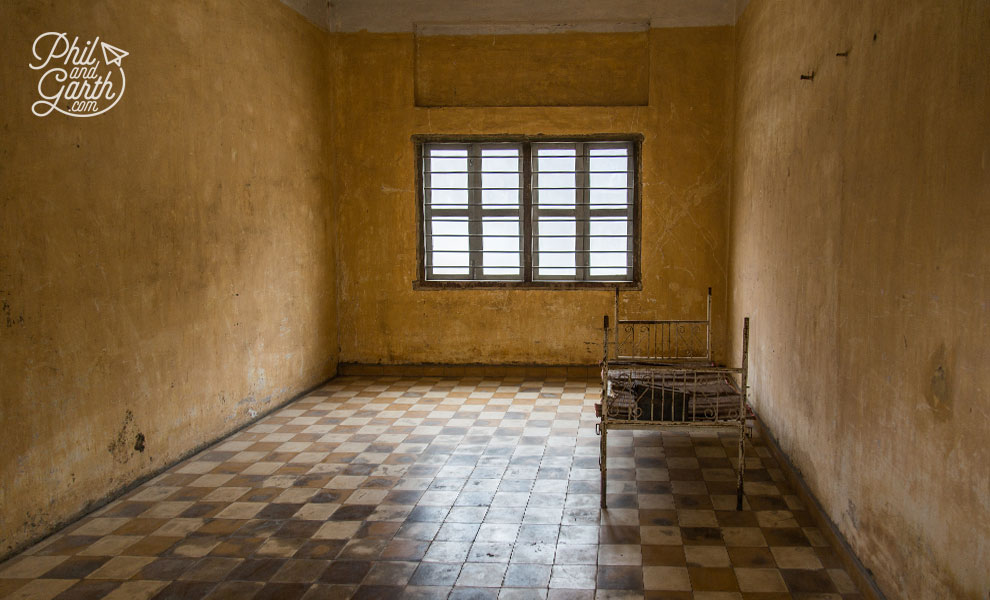
One of torture rooms with blood stains on the floor
It used to be a primary school before it was turned into a prison, 20,000 people were tortured here and just 12 people survived. It was quite harrowing at times seeing inside the rooms because everything has been left how it was, there are still blood stains on many of the floors.
The excellent audio guide walks you through rooms and buildings with information on what you’re looking at. From the torture instruments used to tiny cells and exhibitions of photographs – it’s horrific. It’s an uncomfortable experience and it will have a lasting effect on you. Admission is US$2 and the audio guide is US$6.
Getting around Phnom Penh
We took a tuk tuk (which are more like motorised rickshaws) to Choeung Ek and the Tuol Sleng Genocide Museum. After negotiating a fee of US$25 for the afternoon our driver stopped and waited for us at each site. Getting there was an adventure in itself, the worst bit was being right in the thick of the traffic at exhaust level. Our driver stopped and bought us 2 face masks as the smell was pretty bad. We also witnessed tons of plastic bags and rubbish dumped along the road side, our driver told us people living outside the city centre are still been educated on the importance of waste disposal and recycling but it’s going to take time.
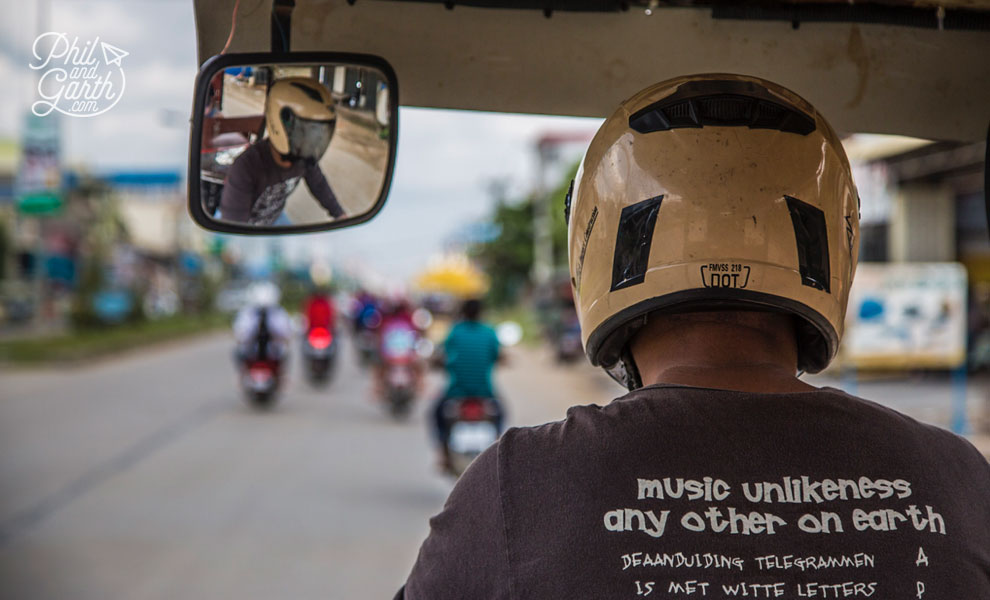
Taking a tuk tuk ride
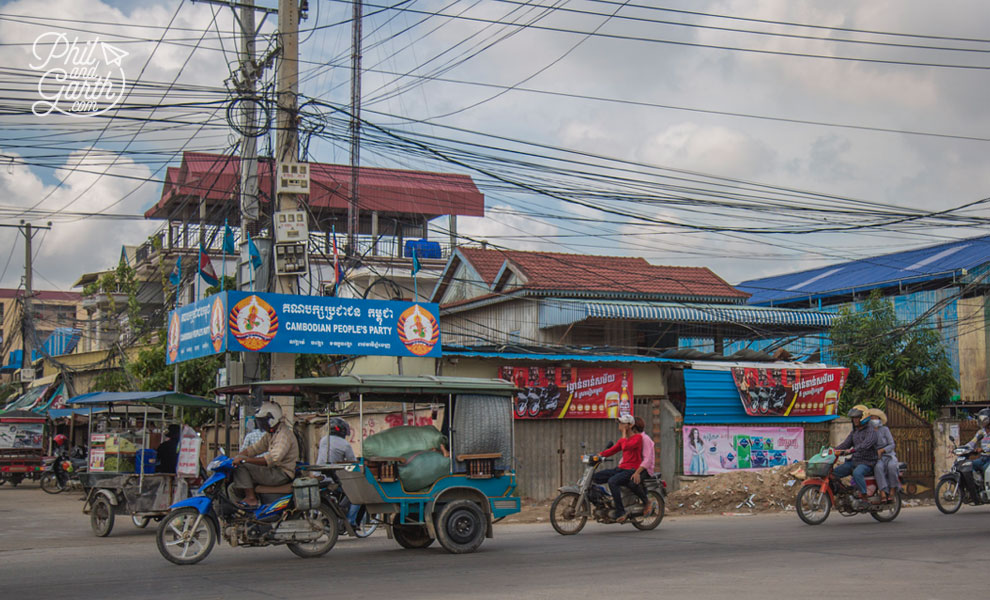
Sights from our tuk tuk ride
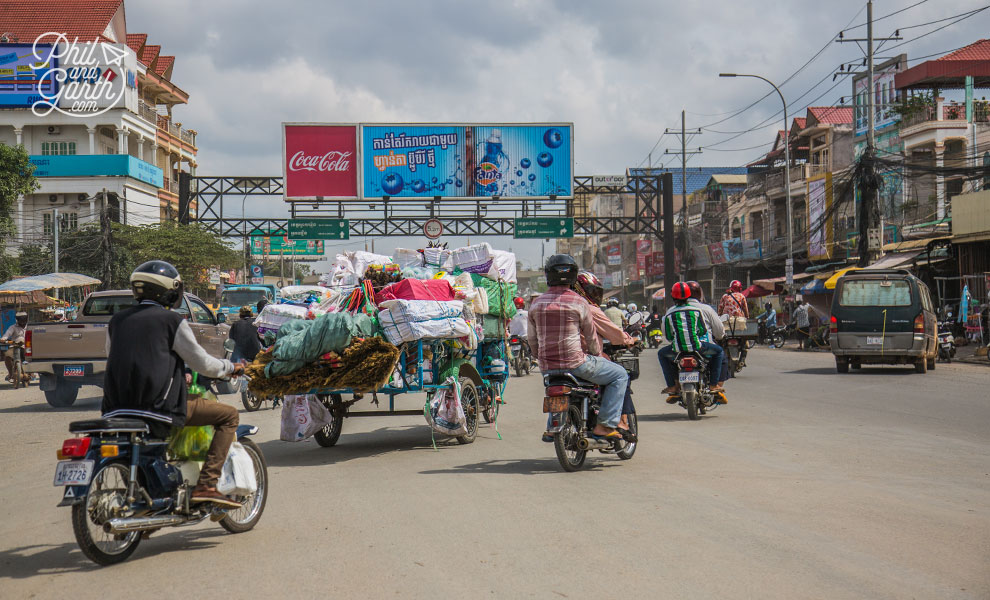
The traffic of Phnom Penh
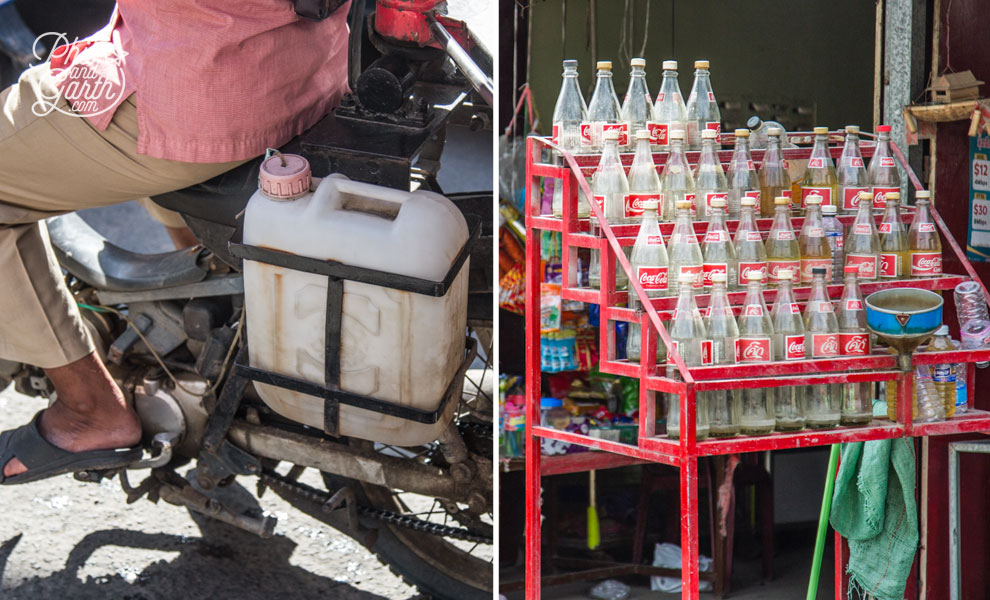
A typical petrol station – bottles of fuel!
Phil was fascinated by the mini petrol stations along the roads, which consisted of some old Coke bottles filled with fuel. We even saw these inside a shop! that was an accident waiting to happen. Garth loved catching fleeting glimpses of local life, like monks making their way to temples or seeing people huddled around a tv watching Khmer style boxing.
Phnom Penh Practical Information & Useful Advice
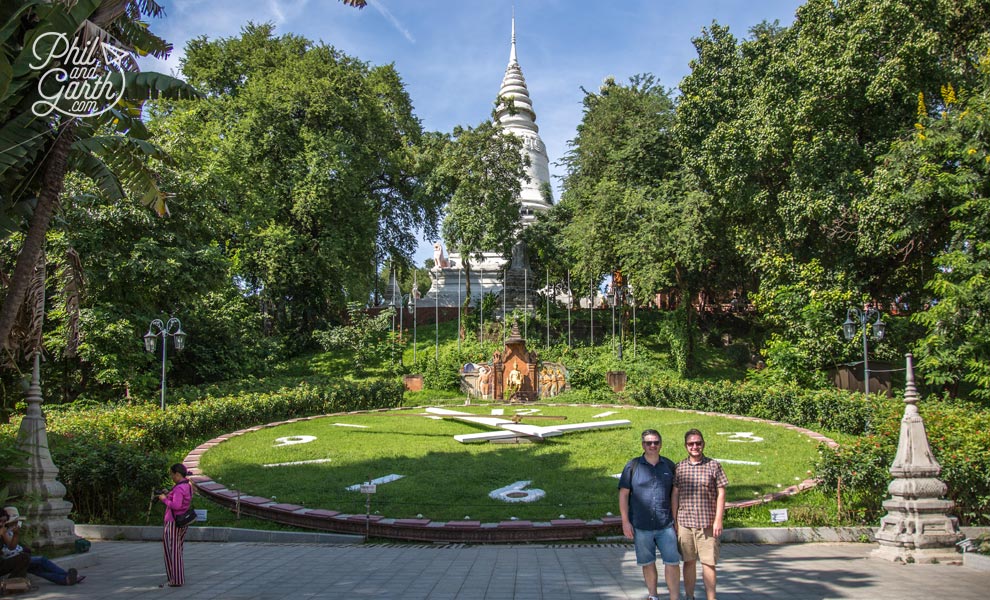
Phil and Garth at the Floral Clock, Wat Phnom
Phil and Garth’s Top 5 Phnom Penh Tips
- Tip #1: Most of the Royal Palace buildings face east, so the best time for photos is in the morning.
- Tip #2: Humidity is very high in November so drink lots of water and carry bottles with you.
- Tip #3: Carry hotel business cards to show to tuk tuk drivers. If the driver is not 100% sure, don’t take the ride.
- Tip #4: Always agree on a price with the driver before you get in a tuk tuk.
- Tip #5: Want to go shopping? try the Russian Market, popular with tourists.
How We Did It
- We paid for a tour of Cambodia (Vietnam & Cambodia Uncovered) with Inside Asia Tours.






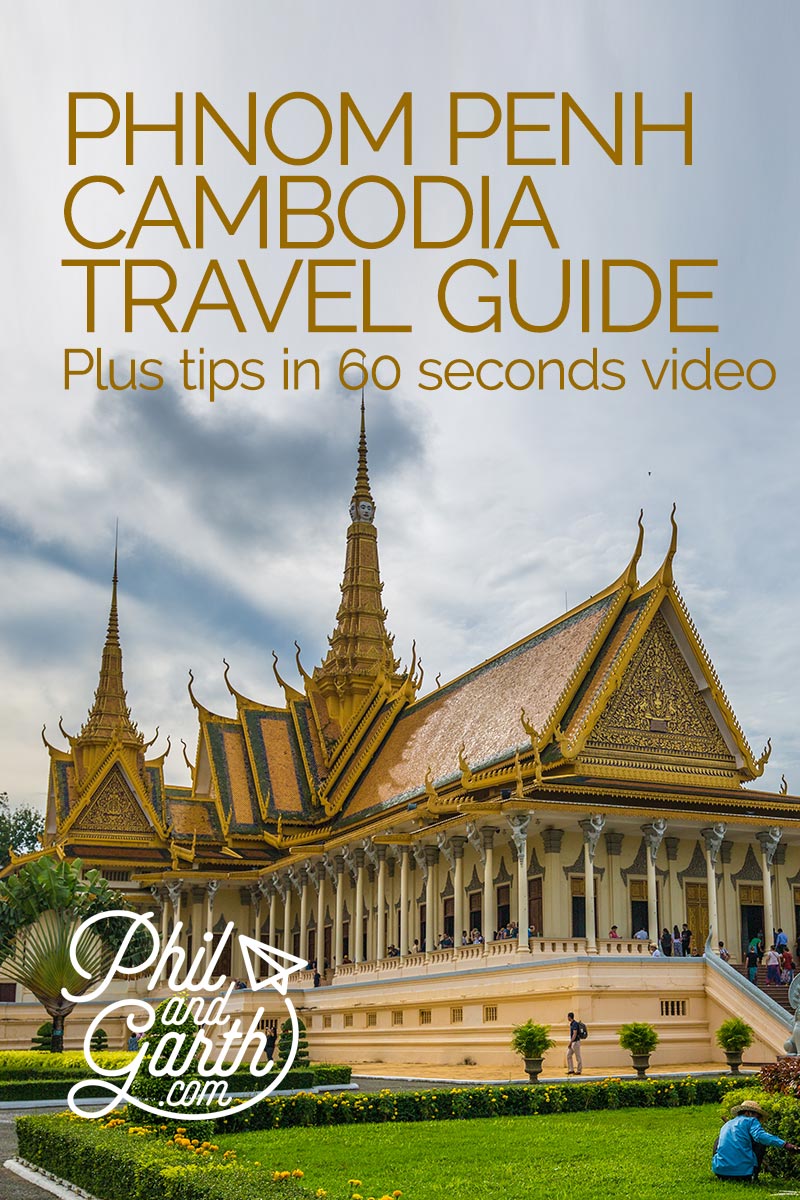
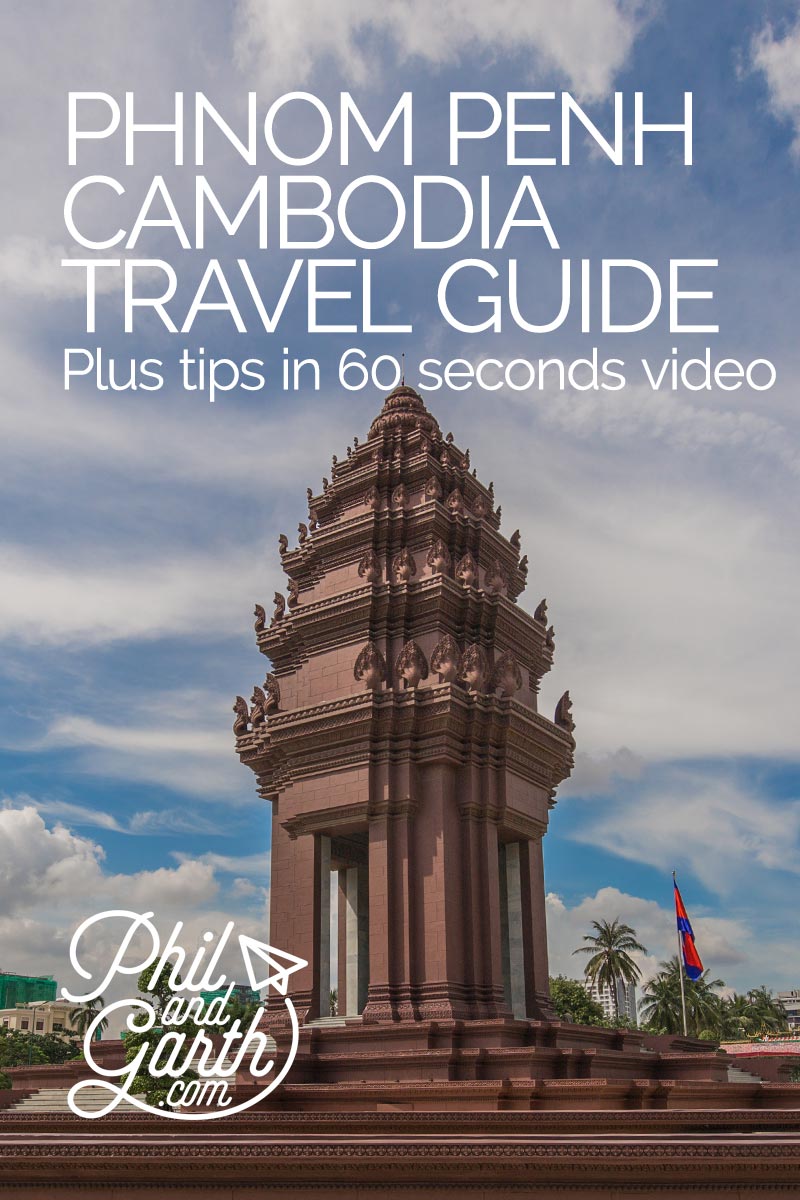
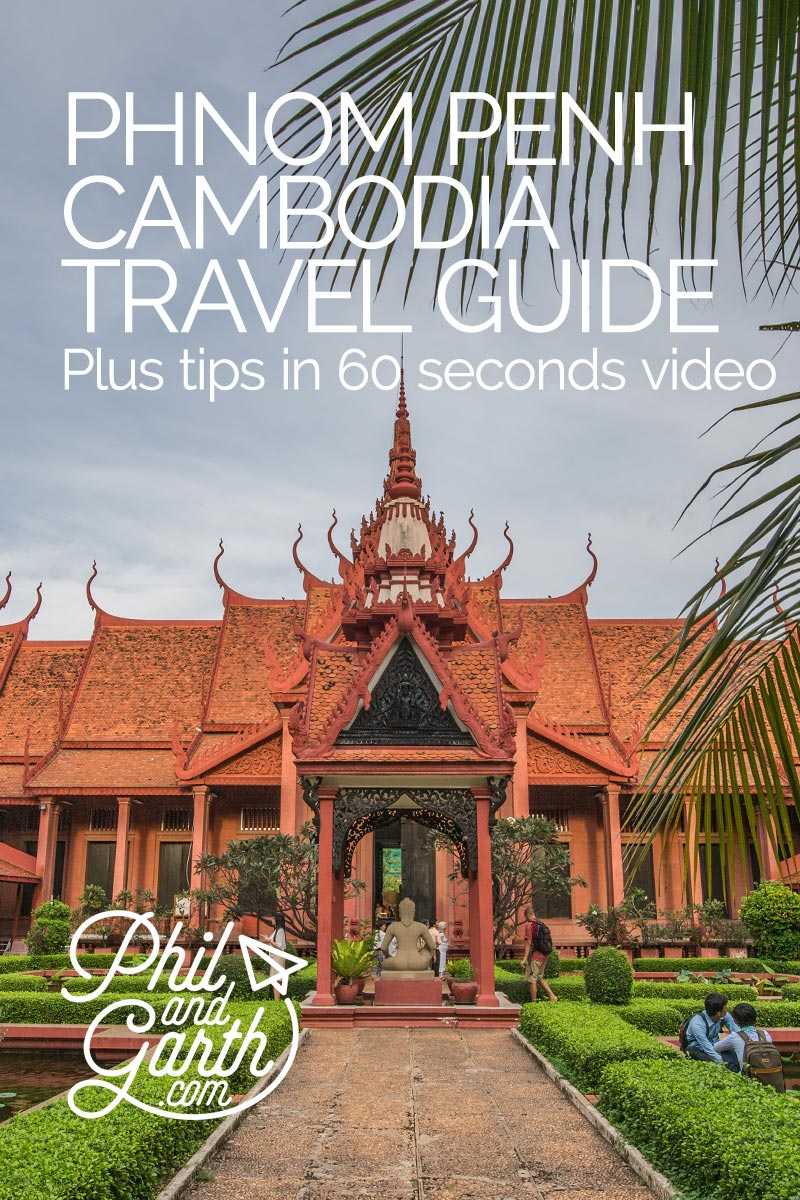
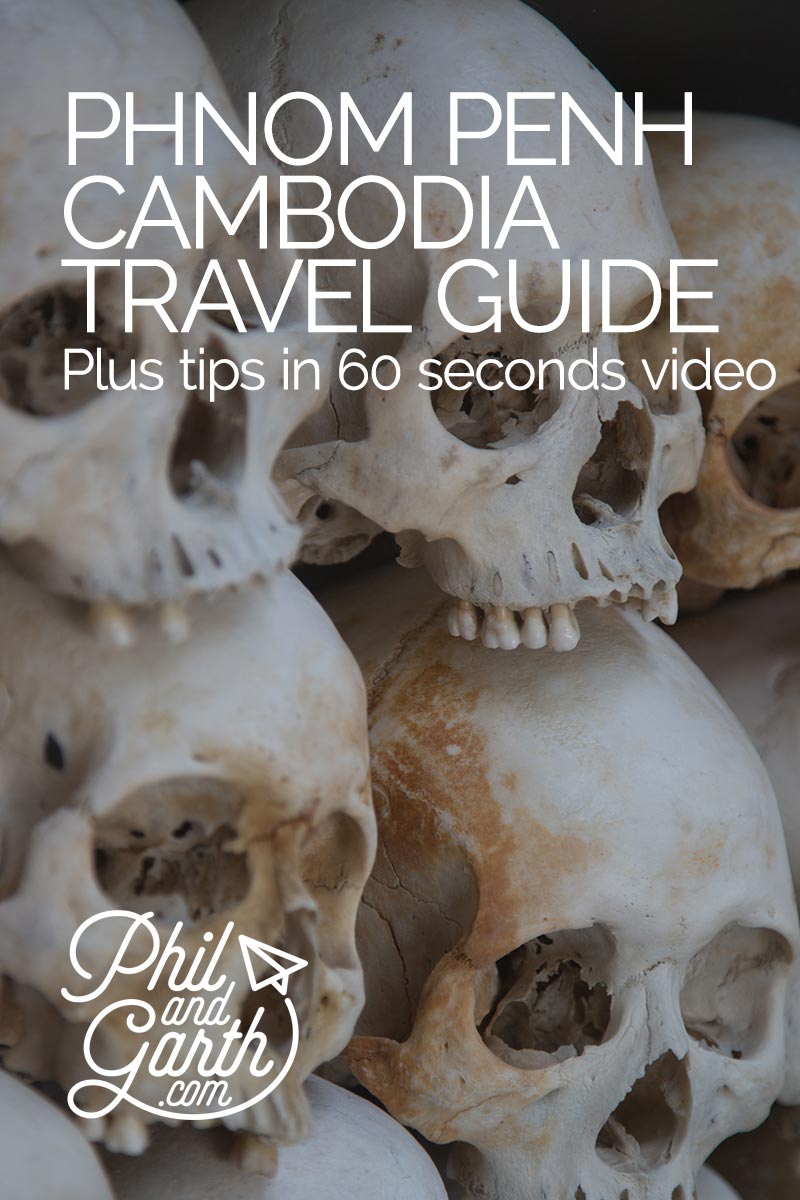
11 comments
Phnom Penh used to be a regular for my Thai visa runs and I’ve recently returned after a 3-year gap. A lot has changed with many new buildings on the island and the riverside has been cleaned up significantly. I love that town!